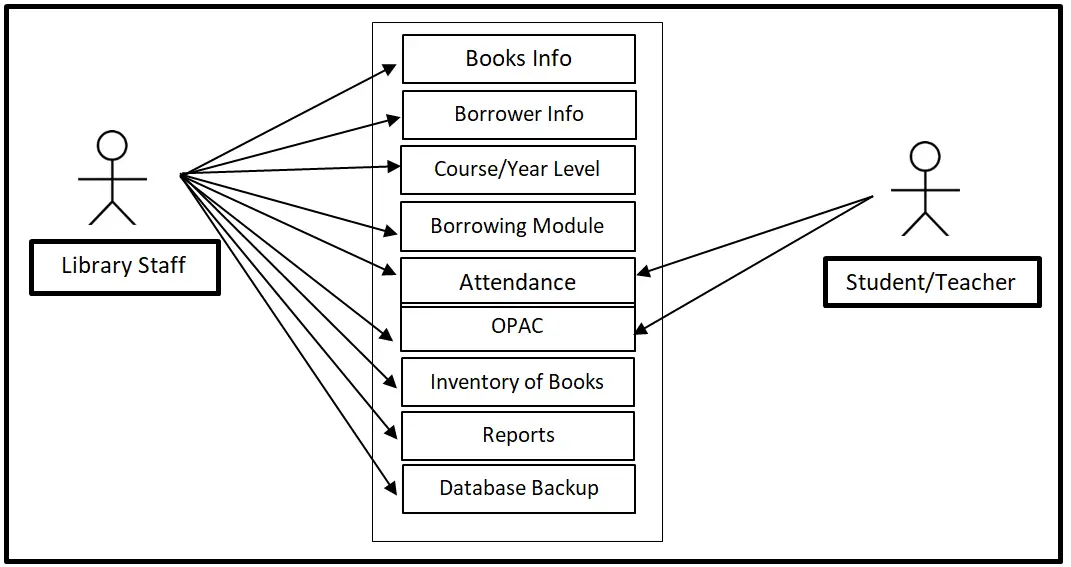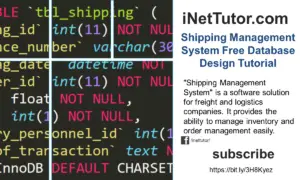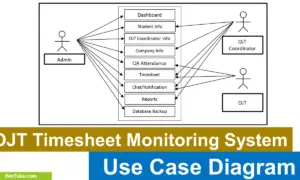Library System Use Case Diagram
A Library System Use Case Diagram is a visual representation of the interactions between different actors and the library system being developed. This type of diagram is used to identify and document the different use cases, or scenarios, that the library system will need to support. It provides a clear and concise overview of the system’s functionality, making it a valuable tool for both development and communication. In this blog post, we will explore the components of a Library System Use Case Diagram, the benefits of using one, and how it can be used to ensure that the library system meets the needs of all stakeholders. Whether you are a librarian, a software developer, or simply interested in understanding how library systems work, this post will provide valuable insights and information on this topic.
About the Project
Libraries serve as one source of knowledge that provides numerous resources such as books, articles, journals, and many more. A librarian is a person in charge of a library, who is in charge of many parts of the library, such as information about books, magazines, and other library items. Information regarding its clients or borrowers must also be kept up to date and well-organized by the librarian. The capstone project, entitled “Library System” is designed to automate the management of libraries. The said initiative will empower libraries with smart means to operate and transact automated with library users. The said project will allow librarians to electronically manage information about books, magazines, and other library materials as well as records management of library users and borrowers.
What is Use Case Diagram?
A use case diagram is a type of diagram used in software engineering to represent the different interactions between actors and the system being developed. In the context of a library system, actors might include librarians, library patrons, and library administrators. The use case diagram outlines the different use cases, or scenarios, that the library system will need to support, such as checking out books, renewing library cards, and managing library inventory.
The use of a use case diagram in the development of a library system provides several benefits. Firstly, it helps to ensure that all stakeholders have a clear understanding of the system’s functionality. This makes it easier for developers to determine which features and functionalities need to be implemented and helps to ensure that the system meets the needs of all stakeholders. Secondly, a use case diagram provides a visual representation of the system’s capabilities, making it easier to identify areas where the system may need to be improved. Finally, the use case diagram can be used as a tool for testing the system, by providing different scenarios for testing which includes all possible interactions and transactions.
In conclusion, the use of a Library System Use Case Diagram is a valuable tool in the development of a library system. It helps to ensure that the system meets the needs of all stakeholders, provides a comprehensive and user-friendly platform for managing library operations, and makes it easier to identify areas for improvement. Whether you are a librarian, a software developer, or simply interested in understanding how library systems work, understanding the use of use case diagrams in library system development is a valuable area of knowledge.
Use Case Diagram

The image shown above is the Use Case Diagram of the Library System. The system has two user sides, the Library Staff and the student/teacher. The Library Staff can access the entire core modules of the system while the Student/Teacher can access the Attendance and OPAC modules.
Use Cases
The following are the discussions that describe how a user uses a system to accomplish a particular goal.
Use Case: Books Info
Actor(s): Library Staff
Description:
This feature is used to manage the information of the books registered in the system.
Successful Completion:
- The library staff can search, add, update and remove book information that are registered in the system.
Alternative: The library staff can access all book information
Precondition: New book for registration, existing book for updating
Post Condition: updated book information
Use Case: Borrower Info
Actor(s): Library Staff
Description:
This feature is used to manage the records of borrower of books in the system.
Successful Completion:
- The library staff can search, add, update and remove borrower information in the record.
Alternative: The library staff can access all borrower information in the system’s record.
Precondition: The library staff will need to login first to access the borrower information in the system
Post Condition: updated borrower information
Use Case: Course/Year Level
Actor(s): Library Staff
Description:
This feature is used to manage the course/year level in the system.
Successful Completion:
- The library staff can search, add, update and remove a course/year level information in the system.
Alternative: None
Precondition: The library staff will need to login first to access the module in the system
Post Condition: updated course/year level module
Use Case: Borrowing Module
Actor(s): Library Staff
Description:
This feature is used to manage the borrowing module in the system.
Successful Completion:
- The library staff can search, add, update and remove a borrowing information to be filled out.
Alternative: None
Precondition: The library staff will need to login first to access the module in the system
Post Condition: updated borrowing module information
Use Case: Attendance
Actor(s): Library Staff and Student/Teacher
Description:
This feature is used to record and manage attendance in the system.
Successful Completion:
- Student/Teacher can record attendance using this module.
- Library Staff can search, add, update and remove attendance details.
Alternative: Student/Teacher can only view and add attendance; Library Staff can access all of the attendance record.
Precondition: The library staff and the student/teacher will login first to record and manage attendance.
Post Condition: updated attendance information

Use Case: OPAC
Actor(s): Library Staff and Student/Teacher
Description:
This feature is used to view and manage Online Public Access Catalog module in the system.
Successful Completion:
- Student/Teacher can view the OPAC.
- Library Staff can search, add, update and remove information in the OPAC.
Alternative: Student/Teacher can only view OPAC; Library Staff can access all of the OPAC information and manage it.
Precondition: The library staff and the student/teacher will login first to view and manage OPAC.
Post Condition: updated OPAC information
Use Case: Inventory of Books
Actor(s): Library Staff
Description:
This feature is used to manage Inventory of Books in the system.
Successful Completion:
- The library staff can search, add, update and remove details in the Inventory of Books module.
Alternative: None
Precondition: The library staff will need to login first to access the module in the system
Post Condition: updated book inventory
Use Case: Reports
Actor(s): Library Staff
Description:
This feature is used to view and print the reports of the system.
Successful Completion:
- Library Staff can view, print and export the report of the system.
Alternative: None
Precondition:
- Library Staff will need to login to access the reports.
Post Condition: hard and soft copy of the report of the system.
Use Case: Database Backup
Actor(s): Library Staff
Description:
This feature is used to manage the backup database of the system.
Successful Completion:
- The library staff can add, edit, update database backup information.
Alternative: None
Precondition: Library Staff will create and connect the backup database.
Post Condition: new backup database.
Summary
The capstone project, entitled “Library System” is designed to automate the management of libraries. The said initiative will empower libraries with smart means to operate and transact automated with library users. The image shown above is the Use Case Diagram of the Library System. The system has two user sides, the Library Staff and the student/teacher. The Library Staff can access the entire core modules of the system while the Student/Teacher can access the Attendance and OPAC modules.
Readers are also interested in:
Library System in PHP and MySQL User Interface
Library Management System in Laravel Free Source Code
Library System Conceptual Framework
You may visit our Facebook page for more information, inquiries, and comments. Please subscribe also to our YouTube Channel to receive free capstone projects resources and computer programming tutorials.
Hire our team to do the project.


